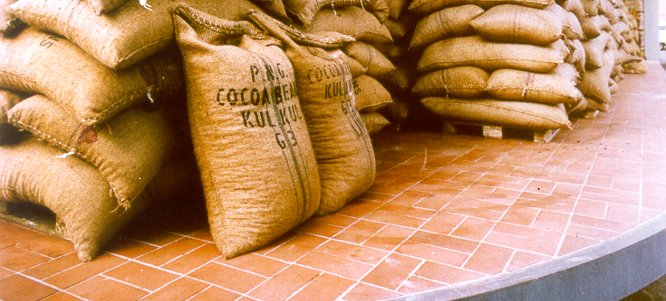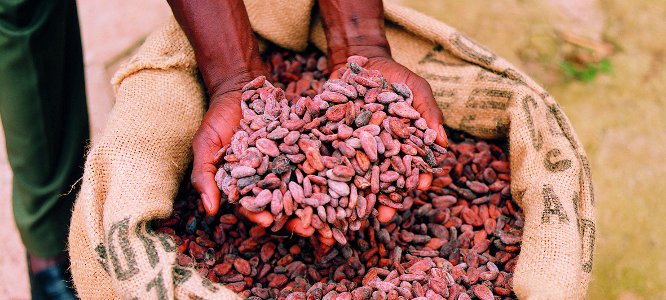Trading and Shipping cocoa beans
When discussing cocoa trading, a clear distinction has to be made between the actual or physical markets and the futures or terminal markets. Nearly all cocoa coming from origin countries is sold through the physical market. The physical market involves the type of business that most people normally think of when talking about trading in commodities. The structure and length of the cocoa marketing channels differ from region to region within the same producing country as well as across producing countries. At one extreme of the spectrum, the marketing channel between cocoa farmers and exporters encompasses at least two middlemen: small traders and wholesalers. Small traders buy cocoa beans directly from farmers, visiting them one by one. In a second stage, small buyers sell the beans to wholesalers, who in turn will re-sell them to exporters. At the other extreme of the spectrum, cocoa beans are sold directly to exporters by farmers’ cooperatives or even directly exported by the co-operative.
At the Port
Once cocoa beans reach the port of export, they are stocked in warehouses, while being graded and subsequently loaded onto cargo vessels. Warehouses should have cement and non-flammable floors without cracks and crevices where insects can hide. Ideally, the floor level of the warehouse should be higher than the surrounding land to prevent flooding and to allow water to flow away. In some producing countries, cocoa beans are processed in the conditioning plants, most of them located in port warehouses because of the high moisture level of the beans and a high variance in their quality. Conditioning — either by hand or mechanically — is also used to blend poor quality with good quality beans.
Cocoa Grading
Cocoa grading differs across producing and consuming countries. However, over the years, the physical market has developed standard practices set out by the main international cocoa trade associations: the Federation of Cocoa Commerce Ltd (FCC) and the Cocoa Merchants’ Association of America, Inc. (CMAA). For example, FCC distinguishes three grades; Good Fermented (GF), Fair Fermented (FF) and Fair Average Quality (FAQ). Cocoa described as either Good or Fair Fermented are defined by specific quality parameters (not more than 5% defective or 5% slate, not more than 10% defective or 10% slate, respectively) while FAQ is used when GF or FF are not customarily applicable to the origin described. These faults are determined by analysis by the ‘cut test’. Such a test involves counting off a given number or weight of cocoa beans, cutting them lengthwise through the middle, and then examining them. Separate counts are made of the number of beans which are mouldy, slaty, insect damaged, germinated or flat.
Once cocoa beans have been graded and loaded into cargo vessels, they are shipped either in new jute bags or in bulk. In recent years, shipment of cocoa beans in bulk has been growing in popularity because it can be up to one third cheaper than conventional shipment in jute bags. Loose cocoa beans are loaded either in shipping containers or directly into the hold of the ship, the so-called “mega-bulk” method. The latter mode is often adopted by larger cocoa processors.
Cocoa Futures Contracts
In general, cocoa futures contracts are not used to secure the supply of cocoa beans, but rather to offset the risk of adverse price movements. A cocoa futures contract is a commitment to make or to take delivery of a specific quantity and quality of cocoa beans at a predetermined place and time in the future. All contract terms are standardized and set in advance. As a result, cocoa futures contracts are interchangeable, except for delivery time.
There are currently three places where cocoa futures contracts can be exchanged: ICE Futures U.S. (New York), ICE Futures Europe (London) and CME Europe (London).
Prior to March 2015, cocoa futures contracts were quoted only in British pounds sterling and in U.S. dollars. However, as almost half of the cocoa traded originates from Côte d’Ivoire, Cameroon and Togo (whose currencies are pegged to the Euro), and a third of world cocoa production is processed within the Eurozone, new Euro-denominated contracts were introduced in March 2015, thereby reducing the need to hedge against foreign exchange risks in the cocoa trade. Cocoa futures contacts are now available in the three currencies.
These organized exchanges provide the facilities and trading platforms that bring buyers and sellers together. Moreover, they set and enforce rules to ensure that trading takes place in an open and competitive environment. For this reason, all bids and offers must be made through the Exchange’s “Clearing House”, via the exchange’s electronic order-entry trading system. As a result, the Exchange’s Clearing House acts as the buyer to all sellers and the seller to all buyers.
The Exchange’s Clearing House
To enter into a transaction with the Exchange’s Clearing House, a broker must deposit a specified amount of money to guarantee his or her commitment to the terms of the contract. This money is called “initial margin”, and is a small proportion (i.e. 2%-10%) of the total value of the contract. Once a contract is open, the position is “marked to the market” daily. If the futures position loses value (i.e., if the market moves against it – e.g., the trader is long and the market goes down), the amount of money in the margin account will decline accordingly. For example, if the price of cocoa declines by one dollar per tonne or $10 per contract (i.e. a cocoa futures contract calls for delivery of a lot size of 10 tonnes of cocoa beans), this amount is subtracted from the accounts of all buyers and added to the accounts of all sellers. If the amount of money in the margin account falls below the specified maintenance margin (which is set at a level less than or equal to the initial margin), the futures trader will be required to post additional variation margin to bring the account up the initial margin level. On the other hand, if the futures position is profitable, the profits will be added to the margin account. It is worth noting that, while the initial margin is small, a trader with a large and consistently losing position may have to tie up significant volumes of cash to maintain the margin.
Futures market participants fall into two general categories: commercial (i.e. hedgers) and non-commercial traders (i.e. speculators). Commercial traders are market participants who try to avoid or reduce a possible loss in the cash market by making counterbalancing transactions in the futures market. On the other hand, non-commercial traders do not produce or use a commodity, but risk their own capital by trading futures in that commodity in the hope of making a profit on price changes.
Contact details for international cocoa trade associations
The Federation of Cocoa Commerce (FCC)
2nd Floor
30 Watling Street
London EC4M 9BR
UNITED KINGDOM
Tel: +44 (020) 3773 6200
Fax: +44 (020) 7489 4845
Cocoa Merchants’ Association of America (CMAA)
55 E. 52nd Street
40th Floor
New York, NY 10055
USA
Tel: +1 (212) 748 4193
The European Cocoa Association (ECA)
Avenue des Gaulois 3, Box 9
B-1040 Brussels
BELGIUM
Tel: +32 (2) 662 0006
Fax: +32 (2 662 0008
National Confectioners Association (NCA)
1101 30th Street NW
Suite 200
Washington, DC 20007
USA
Tel: +01 (202) 534-1440
Fax: +01 (202) 337-0637
Cocoa Association of Asia (CAA)
5 Shenton Way
UIC Building, #10/11-01
Singapore 068808
Singapore



